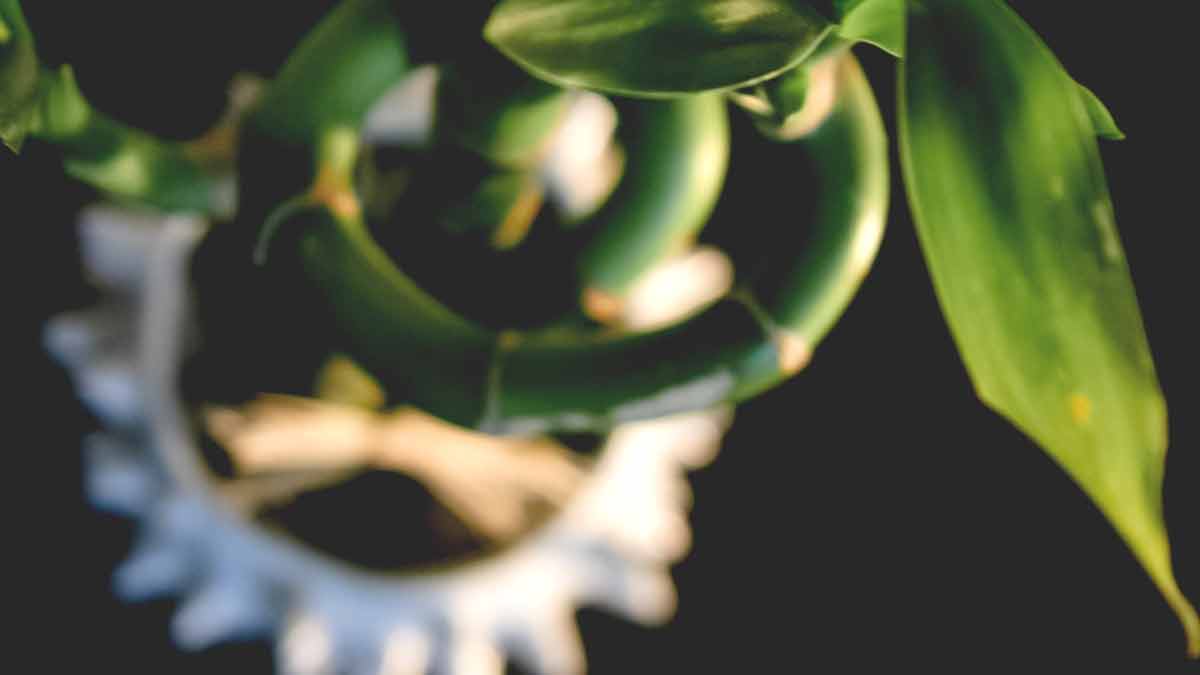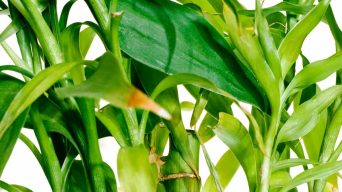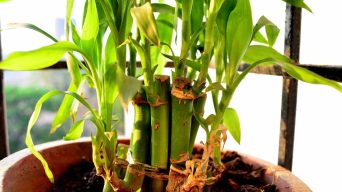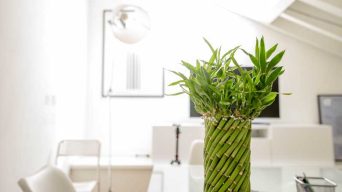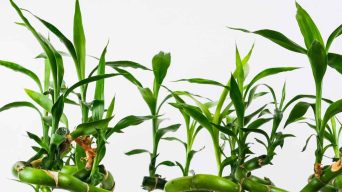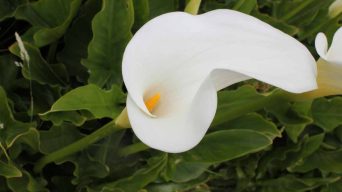Lucky bamboo leaves can turn yellow due to overwatering, poor water quality, direct sunlight, temperature changes, or overfertilization. Catching the issue early can help revive the plant. Yellowing tips may indicate too much light or fertilizer. Chlorine and fluorides in tap water can also cause brown tips.
Are you wondering why your once-vibrant lucky bamboo plant is now sporting yellow leaves?
There could be several reasons for this unfortunate change in appearance.
This blog post will delve into the top seven factors that may cause Lucky bamboo (Dracaena sanderiana) to lose its lush green color and turn yellow.
We’ll also discuss how to revive these popular feng shui houseplants and some preventative measures you can take to avoid future yellowing issues.
Reasons Why Your Lucky Bamboo Leaves Are Turning Yellow
Homes are often adorned with Lucky Bamboo plants as they are a low-maintenance and aesthetically pleasing addition to any home or garden.
However, if you notice yellowing leaves, it could be a sign of a problem.
Here we will explore seven possible reasons why your Lucky Bamboo leaves are turning yellow and what you can do to remedy the situation.
Understanding these reasons can help you take better care of your plant and keep it thriving.
1. Overwatering
Overwatering is one of the most common culprits behind lucky bamboo leaves turning yellow.
Plant enthusiasts often have good intentions in providing their beloved plants with sufficient hydration.
Still, excessive water can cause more harm than good.
To prevent overwatering, ensure your lucky bamboo plant is placed in a pot with proper drainage holes so excess water can escape easily.
Be mindful of your watering schedule: check the soil’s moisture level by sticking your finger an inch into it.
If it feels damp or wet, hold off on additional watering until it starts to feel dry again.
2. Lack Of Water
The lack of water is a surprising cause of the lucky bamboo turning yellow.
Although this hardy plant can tolerate some neglect, allowing it to dry out completely for long periods could lead to wilting and eventual leaf discoloration.
To prevent this issue, ensure that you provide enough moisture for your lucky bamboo without overwatering.
This can be achieved by keeping the water level consistent and using filtered or distilled water, since tap water often contains chemicals and minerals detrimental to your bamboo’s health.
3. Poor Water Quality
One primary reason lucky bamboo leaves turn yellow is poor water quality.
Lucky bamboo plants thrive in clean, filtered, or distilled water, as they are sensitive to chemicals found in tap water, such as chlorine and fluoride.
To ensure optimal growth and vibrant green leaves for your lucky bamboo, it’s crucial to use filtered or distilled water while avoiding tap water altogether.
Not only does this prevent harmful substances from damaging the plant, but it also maintains a proper balance of nutrients that promote healthy growth.
For example, you may notice an improvement in leaf color after switching from chlorinated tap water to bottled spring water or collected rainwater.
4. Inadequate Lighting
One common reason why lucky bamboo turns yellow is inadequate lighting.
Lucky bamboo prefers bright, indirect light and can suffer nutrient deficiency when overexposed or underexposed to light.
Placing your lucky bamboo in a spot with adequate natural or artificial light is important to avoid this issue.
Consider placing your plant near a window that receives filtered sunlight or using grow lights if necessary.
Regularly monitoring your bamboo stalks and adjusting their placement for optimal growth and health is essential.
5. Extreme Temperatures
Extreme temperatures are another reason why lucky bamboo leaves may turn yellow.
Lucky bamboo plants thrive in temperatures between 65°F and 90°F, so exposing them to temperatures outside of this range can cause stress to the plant, leading to yellowing or browning of its leaves.
When choosing the best location for your lucky bamboo, it is important to consider the amount of light and temperature that it will be exposed to.
While it is important to provide your plant with indirect sunlight, it is important to avoid placing it in locations that receive direct sunlight, as this can cause extreme temperature fluctuations and lead to leaf discoloration.
6. Overfertilization
Overfertilization can be a common reason why lucky bamboo leaves turn yellow.
While it is essential to nourish your plant, too much fertilizer can cause nutrient burn, which leads to the yellowing of the leaves.
Lucky bamboo plants require minimal fertilization since they grow slowly and do not need as many nutrients as other houseplants.
To prevent overfertilizing your lucky bamboo, use only half or a quarter of the recommended amount and fertilize once every three months.
Additionally, ensure you water your plants before adding fertilizer to avoid concentration issues.
Remember that less is more when it comes to fertilizing lucky bamboo plants.
7. Aging
Like all living things, lucky bamboo plants undergo a natural aging process.
As the plant ages, its leaves and stalks may turn yellow and eventually die.
However, it’s important to note that not all yellowing can be attributed to aging.
If your plant is young or middle-aged and showing signs of yellowing, it could be due to other factors such as overwatering, poor water quality, or inadequate lighting.
Identifying the root cause of yellowing before taking any corrective measures is essential.
Gardening is a hobby that requires a lot of care and attention, and the yellowing of plants can be caused by a variety of factors, so it is important to identify the root cause of the yellowing before taking any corrective measures in order to ensure successful gardening.
How To Revive Yellow Lucky Bamboo Leaves
Reviving yellow Lucky Bamboo leaves is an easy process that requires proper care and attention.
To revive them, you need to trim the leaves with clean scissors, adjust the watering schedule to avoid over or underwatering, use filtered or distilled water for better water quality, provide adequate bright indirect lighting, and use appropriate fertilizer every two to four weeks.
These steps will help restore your Lucky Bamboo’s health and return it to its vibrant green color.
1. Trim Yellow Leaves
If you notice yellow leaves on your lucky bamboo, acting quickly to prevent further damage is crucial. The first step in reviving your plant is to trim the affected leaves.
Using sharp and clean scissors or pruning shears, carefully cut the yellowed leaves of the bamboo stalk close to the stem to help promote healthy growth and prevent further damage to the plant.
It’s important not to remove too many leaves simultaneously, as this can further stress your lucky bamboo. Instead, take a gradual approach and monitor how the plant responds over time.
Remember that removing yellowed leaves alone may not be enough to address underlying issues causing yellowing in other parts of the plant.
2. Adjust Watering Schedule
One of the most common reasons for yellowing leaves in lucky bamboo plants is improper watering.
Overwatering or underwatering can make the lucky bamboo plant vulnerable to root rot, leading to yellow leaves and death.
Adjusting your watering frequency based on your climate and your plant’s needs is essential to avoid this problem.
Typically, lucky bamboo requires well-drained soil that stays moist but not soggy.
You may need to water it more frequently in dry conditions than in humid conditions.
It’s also important not to let water sit in a saucer or tray beneath the pot since this can encourage root rot by creating a stagnant environment.
3. Improve Water Quality
One potential reason lucky bamboo leaves turn yellow is poor water quality.
Tap water can contain high levels of chlorine and fluoride, which can harm plants.
Using filtered or distilled water will help ensure that your lucky bamboo receives clean and healthy moisture.
Additionally, stagnant water in the container can lead to root rot, which can cause yellowing leaves.
To avoid this problem, change the water regularly and ensure the roots are not submerged in standing water for extended periods.
4. Provide Proper Lighting
Proper lighting is crucial for keeping your lucky bamboo healthy and vibrant.
To keep your lucky bamboo healthy and vibrant, it is important to provide it with adequate energy from sunlight or artificial light sources, as insufficient light can cause leaves to turn yellow, drop off, or even die.
Lucky bamboo plants thrive in bright, indirect light, which means they should be kept out of direct sunlight but still receive enough natural light to grow properly.
Notice that your plant is turning yellow despite adequate watering and fertilization. It may be a sign that it’s not getting enough light.
Consider moving your lucky bamboo to a brighter location with more exposure to natural light.
If you’re having trouble getting enough light for your lucky bamboo, try placing it near an east- or west-facing window, where it will be exposed to natural light throughout the day, allowing it to flourish.
Alternatively, you can supplement its lighting with artificial sources such as fluorescent bulbs or LED lights designed for indoor plants.
Keep in mind that too much light can also damage your plant, so finding the right balance is critical.
5. Use Appropriate Fertilizer
The solution to preventing lucky bamboo leaves from turning yellow is to use the appropriate fertilizer, which is essential for providing the necessary nutrients to the plant and ensuring its health and longevity.
Overfertilizing your plant can damage it, causing discoloration and stunted growth.
When choosing a fertilizer for your lucky bamboo, look for one that contains nitrogen, phosphorus, and potassium – three key components that promote healthy growth.
Following the instructions on the label when applying fertilizer is vital to avoid overfeeding your plant.
Generally, you should only fertilize your lucky bamboo every 2-4 months during its active growing season (spring and summer) and cut back on feeding during its dormant period (fall and winter).
Preventative Measures To Avoid Yellow Bamboo Leaves
If you want to keep your Lucky Bamboo looking lush and healthy, there are some preventative measures you can take to avoid yellowing.
One of the most important steps is to select a pot with adequate drainage and ensure the plant is watered properly.
While it’s crucial to water the plant thoroughly, it’s equally important not to let it sit in standing water.
By taking these steps, you can help keep your Lucky Bamboo leaves green and vibrant for longer.
1. Choose The Right Pot
Choosing the right pot is essential to maintaining the health of your lucky bamboo and preventing yellowing leaves.
A too large or small container can affect nutrient absorption, leading to stunted growth, root rot, and other issues.
A general rule of thumb is to select a vessel that can hold one inch of water above the roots of your lucky bamboo.
Pots should also have drainage holes at the bottom to let excess water flow easily.
Using a decorative container without drainage may cause standing water around the roots, which promotes bacterial growth and root rot.
2. Water Properly
To keep your lucky bamboo healthy and vibrant, it’s essential to water it properly.
Overwatering can cause the roots to become waterlogged, leading to root rot and yellowing leaves.
To avoid these issues, ensure you water your lucky bamboo correctly by providing enough water without overdoing it.
As a general rule of thumb, use only distilled or filtered water when watering your plant to avoid any buildup of minerals from tap water.
It’s also crucial not to allow excess water in the pot because standing water can lead to root rot.
Therefore, ensure proper drainage so any excess moisture can escape easily.
3. Use Filtered Water
Using filtered water can be beneficial in preventing the yellowing of lucky bamboo leaves.
Tap water contains minerals and chemicals that may not be suitable for the delicate bamboo plant, causing leaf discoloration over time.
Using distilled or bottled water is also an option, but can become costly in the long run.
It’s essential to note that changing the type of water used should be done gradually over time to avoid shocking the plant’s roots.
Additionally, it’s crucial to keep track of watering schedules and maintain an appropriate level of humidity around the plant as well.
4. Ensure Optimal Lighting
One of the main causes of yellowing lucky bamboo leaves is inadequate lighting.
Lucky bamboo plants thrive in bright, indirect light, and a lack of this can lead to the yellowing or browning of leaves.
Another critical factor in optimal lighting for lucky bamboo is avoiding direct sunlight exposure.
While they require brightness, they do not tolerate direct sun well and may suffer from leaf burn if exposed for prolonged periods.
If you notice that your plant’s leaves are turning yellow while exposed to direct sunlight, consider moving them away from the window or using sheer curtains to filter out some of the sun’s harsh rays.
5. Maintain Ideal Temperature
Maintaining the ideal temperature is crucial in keeping your lucky bamboo leaves healthy and vibrant.
These plants thrive best in warm environments, with temperatures ranging from 65-95°F.
One way to maintain optimal temperature for your lucky bamboo is by keeping it away from drafty areas such as air conditioners or heating vents.
Consider using a thermometer to monitor the room temperature daily.
Consistency is key – sudden temperature changes can stress the plant and lead to leaf discoloration or death.
Final Thoughts
Proper lucky bamboo care is essential to ensure that your plant stays healthy and vibrant, as incorrect care can lead to yellowing or dying leaves, discoloration, and other issues.
Factors such as overwatering or poor water quality can cause stress to the plant and lead to yellowing leaves.
However, with proper care, such as adjusting the watering schedule and providing appropriate lighting, you can keep your lucky bamboo healthy and thriving.
Remember to trim any yellow leaves and avoid using direct sunlight or extreme temperatures.

